GOOD NEWS:Lead2pass has timely updated the 70-411 exam questions. With all the new questions and answers, you will pass the Microsoft 70-411 exam easily. Get more 70-411 exam dumps and free download the new version VCE player from Lead2pass. All the dumps are new updated and cover all aspect of the examination.
QUESTION 1
Your network contains an Active Directory domain named contoso.com.
The domain contains a domain controller named DC1 that runs Windows Server 2012 R2.
All client computers run Windows 8 Enterprise. DC1 contains a Group Policy object (GPO) named GPO1.
You need to deploy a VPN connection to all users.
What should you configure from Users Configuration in GPO1?
A. Policies/Administrative Templates/Network/Network Connections
B. Policies/Administrative Templates/Network/Windows Connect Now
C. Preferences/Control Panel Settings/Network Options
D. Policies/Administrative Templates/Windows Components/Windows Mobility Centre
Answer: C
Explanation:
http://technet.microsoft.com/en-us/library/cc772107.aspx
To create a new Dial-Up Connection preference item
Open the Group Policy Management Console.
Right-click the Group Policy object (GPO) that should contain the new preference item, and then click Edit.
In the console tree under Computer Configuration or User Configuration, expand the Preferences folder, and then expand the Control Panel Settings folder.
Right-click the Network Options node, point to New, and select Dial-Up Connection.
QUESTION 2
Your network contains an Active Directory domain named contoso.com. The domain contains domain controllers that run Windows Server 2008, Windows Server 2008 R2 Windows Server 2012, and Windows Server 2012 R2.
A domain controller named DC1 runs Windows Server 2012 R2. DC1 is backed up daily.
During routine maintenance, you delete a group named Group1.
You need to recover Group1 and identify the names of the users who were members of Group1 prior to its deletion.
You want to achieve this goal by using the minimum amount of administrative effort.
What should you do first?
A. Perform an authoritative restore of Group1.
B. Mount the most recent Active Directory backup.
C. Use the Recycle Bin to restore Group1.
D. Reactivate the tombstone of Group1.
Answer: A
Explanation:
The Active Directory Recycle Bin does not have the ability to track simple changes to objects. If the object itself is not deleted, no element is moved to the Recycle Bin for possible recovery in the future. In other words, there is no rollback capacity for changes to object properties, or, in other words, to the values of these properties.
There is another approach you should be aware of. Tombstone reanimation (which has nothing to do with zombies) provides the only way to recover deleted objects without taking a DC offline, and it’s the only way to recover a deleted object’s identity information, such as its objectGUID and objectSid attributes. It neatly solves the problem of recreating a deleted user or group and having to fix up all the old access control list (ACL) references, which contain the objectSid of the deleted object.
Restores domain controllers to a specific point in time, and marks objects in Active Directory as being authoritative with respect to their replication partners.
QUESTION 3
Your network contains an Active Directory domain named adatum.com.
You have a standard primary zone named adatum.com.
You need to provide a user named User1 the ability to modify records in the zone.
Other users must be prevented from modifying records in the zone.
What should you do first?
A. Run the Zone Signing Wizard for the zone.
B. From the properties of the zone, change the zone type.
C. Run the new Delegation Wizard for the zone.
D. From the properties of the zone, modify the Start Of Authority (SOA) record.
Answer: B
Explanation:
The Zone would need to be changed to a AD integrated zone When you use directory-integrated zones, you can use access control list (ACL) editing to secure a dnsZone object container in the directory tree. This feature provides detailed access to either the zone or a specified resource record in the zone. For example, an ACL for a zone resource record can be restricted so that dynamic updates are allowed only for a specified client computer or a secure group, such as a domain administrators group. This security feature is not available with standard primary zones
DNS update security is available only for zones that are integrated into Active Directory.
After you integrate a zone, you can use the access control list (ACL) editing features that are available in the DNS snap-in to add or to remove users or groups from the ACL for a specific zone or for a resource record.
Standard (not an Active Directory integrated zone) has no Security settings:
You need to firstly change the “Standard Primary Zone” to AD Integrated Zone:
Now there’s Security tab:
http://technet.microsoft.com/en-us/library/cc753014.aspx
http://technet.microsoft.com/en-us/library/cc726034.aspx
http://support.microsoft.com/kb/816101
QUESTION 4
Your network contains an Active Directory domain named contoso.com. The domain contains a server named Server1 that runs Windows Server 2012 R2 and has the Network Policy Server role service installed.
You need to enable trace logging for Network Policy Server (NPS) on Server1.
Which tool should you use?
A. The tracert.exe command
B. The Network Policy Server console
C. The Server Manager console
D. The netsh.exe command
Answer: D
Explanation:
You can use log files on servers running Network Policy Server (NPS) and NAP client computers to help troubleshoot NAP problems. Log files can provide the detailed information required for troubleshooting complex problems.
You can capture detailed information in log files on servers running NPS by enabling remote access tracing. The Remote Access service does not need to be installed or running to use remote access tracing. When you enable tracing on a server running NPS, several log files are created in %windir%\tracing.
The following log files contain helpful information about NAP:
IASNAP.LOG: Contains detailed information about NAP processes, NPS authentication, and NPS authorization.
IASSAM.LOG: Contains detailed information about user authentication and authorization.
Membership in the local Administrators group, or equivalent, is the minimum required to enable tracing. Review details about using the appropriate accounts and group memberships at Local and Domain Default Groups
(http://go.microsoft.com/fwlink/?LinkId=83477).
To create tracing log files on a server running NPS
Open a command line as an administrator.
Type netshras set tr * en.
Reproduce the scenario that you are troubleshooting.
Type netshras set tr * dis.
Close the command prompt window.
http://technet.microsoft.co47m/en-us/library/dd348461%28v=ws.10%29.aspx
QUESTION 5
You have a server named Server1 that has the Web Server (IIS) server role installed.
You obtain a Web Server certificate.
You need to configure a website on Server1 to use Secure Socket Layer (SSL).
To which store should you import the certificate?
To answer, select the appropriate store in the answer area.
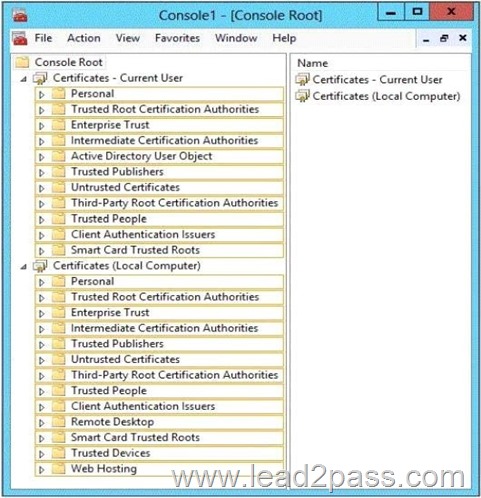
Answer:
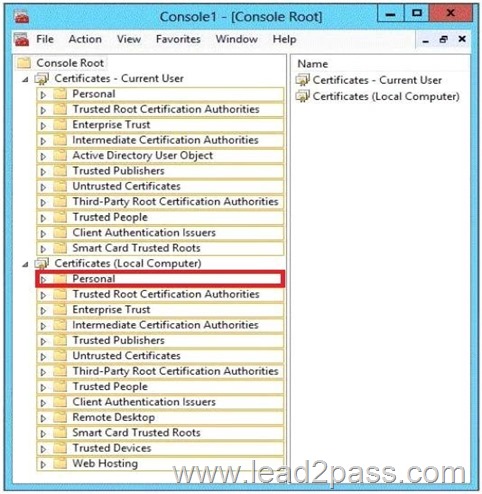
QUESTION 6
Your network contains an Active Directory domain named contoso.com. The domain contains a domain controller named DC1. DC1 is a DNS server for contoso.com.
The properties of the contoso.com zone are configured as shown in the exhibit. (Click the Exhibit button.)
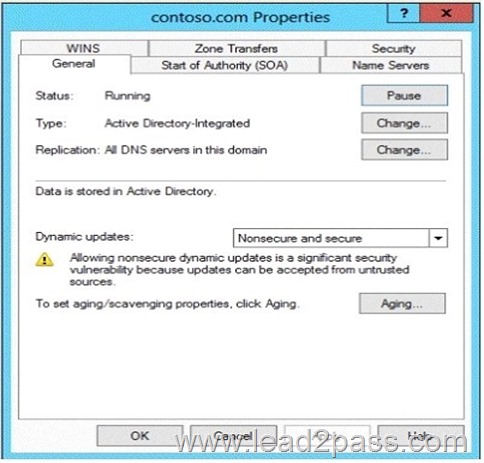
The domain contains a server named Server1 that is part of a workgroup named Workgroup. Server1 is configured to use DC1 as a DNS server.
You need to ensure that Server1 dynamically registers a host (A) record in the contoso.com zone.
What should you configure?
A. The Dynamic updates setting of the contoso.com zone
B. The workgroup name of Server1
C. The primary DNS suffix of Server1
D. The Security settings of the contoso.com zone
Answer: C
Explanation:
When any computer or a standalone server is added to a domain as a member, the network identifies that computer with its Fully Qualified Domain Name or FQDN. A Fully Qualified Domain Name consist of a hostname and the DNs suffix separated by a “.” called period. An example for this can be server01.msftdomain.com where “server01 is the hostname of the computer and “msftdomain.com” is the DNS suffix which follows the hostname. A complete FQDN of a client computer or a member server uniquely identifies that computer in the entire domain.
Primary DNS suffix must manually be added in Windows 8 computer to change its hostname to Fully Qualified Domain Name so that it becomes eligible to send queries and receive responses from the DNS server. Following are the steps which can be implemented to add primary DNS suffix to a Windows 8 computer hostname:
Log on to Windows 8 computer with administrator account.
From the options available on the screen click Control Panel.
On the opened window click More Settings from the left pane.
On the next window click System and Security category and on the appeared window click System. On View basic information about your computer window click Change settings under Computer name, domain, and workgroup settings section.
On System Properties box make sure that Computer Name tab is selected and click Change button.
On Computer Name/Domain Changes box click More button.
On DNS Suffix and NetBIOS Computer Name box type in the DNS domain name as the DNS suffix to the Windows 8 computer under Primary DNS suffix of this computer field. Click Ok button on all the boxes and restart the computer to allow changes to take effect.
For years, Windows DNS has supported dynamic updates, whereas a DNS client host registers and dynamically updates the resource records with a DNS server. If a host’s IP address changes, the resource record (particularly the A record) for the host is automatically updated, while the host utilizes the DHCP server to dynamically update its Pointer (PTR) resource record. Therefore, when a user or service needs to contact a client PC, it can look up the IP address of the host. With larger organizations, this becomes an essential feature, especially for clients that frequently move or change locations and use DHCP to automatically obtain an IP address. For dynamic DNS updates to succeed, the zone must be configured to accept dynamic updates:
http://technet.microsoft.com/en-us/library/cc778792%28v=ws.10%29.aspx
http://technet.microsoft.com/en-us/library/cc778792%28v=ws.10%29.aspx
http://www.advicehow.com/adding-primary-dns-suffix-in-microsoft-windows-8/
http://technet.microsoft.com/en-us/library/cc959611.aspx
QUESTION 7
Your network contains an Active Directory domain named contoso.com. The domain contains six domain controllers named DC1, DC2, DC3, DC4, DC5, and DC6. Each domain controller has the DNS Server server role installed and hosts an Active Directory-integrated zone for contoso.com. You plan to create a new Active Directory-integrated zone named litwareinc.com that will be used for testing.
You need to ensure that the new zone will be available only on DC5 and DC6.
What should you do first?
A. Create an application directory partition.
B. Change the zone replication scope.
C. Create an Active Directory connection object.
D. Create an Active Directory site link.
Answer: A
Explanation:
A partition is a data structure in AD DS that distinguishes data for different replication purposes. When you create an application directory partition for DNS, you can control the scope of replication for the zone that is stored in that partition
http://technet.microsoft.com/en-us/library/cc754292.aspx
QUESTION 8
Your network contains a DNS server named Server1 that runs Windows Server 2012 R2. Server1 has a zone named contoso.com. The network contains a server named Server2 that runs Windows Server 2008 R2. Server1 and Server2 are members of an Active Directory domain named contoso.com.
You change the IP address of Server2. Several hours later, some users report that they cannot connect to Server2.
On the affected users’ client computers, you flush the DNS client resolver cache, and the users successfully connect to Server2.
You need to reduce the amount of time that the client computers cache DNS records from contoso.com.
Which value should you modify in the Start of Authority (SOA) record?
To answer, select the appropriate setting in the answer area.
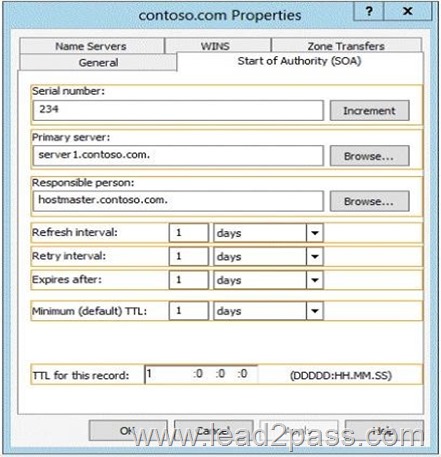
Answer:
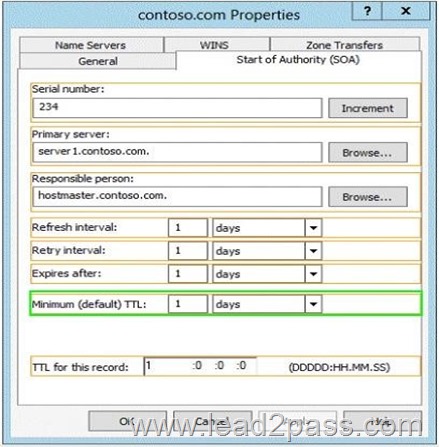
Explanation:
The Default TTL, is just that a default for newly created records. Once the records are created their TTL is independent of the Default TTL on the SOA. Microsoft DNS implementation copies the Default TTL setting to all newly created records their by giving them all independent TTL settings.
SOA Minimum Field: The SOA minimum field has been overloaded in the past to have three different meanings, the minimum TTL value of all RRs in a zone, the default TTL of RRs which did not contain a TTL value and the TTL of negative responses.
Despite being the original defined meaning, the first of these, the minimum TTL value of all RRs in a zone, has never in practice been used and is hereby deprecated. The second, the default TTL of RRs which contain no explicit TTL in the master zone file, is relevant only at the primary server. After a zone transfer all RRs have explicit TTLs and it is impossible to determine whether the TTL for a record was explicitly set or derived from the default after a zone transfer. Where a server does not require RRs to include the TTL value explicitly, it should provide a mechanism, not being the value of the MINIMUM field of the SOA record, from which the missing TTL values are obtained. How this is done is implementation dependent.
TTLs also occur in the Domain Name System (DNS), where they are set by an authoritative name server for a particular resource record. When a caching (recursive) nameserver queries the authoritative nameserver for a resource record, it will cache that record for the time (in seconds) specified by the TTL. If a stub resolver queries the caching nameserver for the same record before the TTL has expired, the caching server will simply reply with the already cached resource record rather than retrieve it from the authoritative nameserver again.
Shorter TTLs can cause heavier loads on an authoritative nameserver, but can be useful when changing the address of critical services like Web servers or MX records, and therefore are often lowered by the DNS administrator prior to a service being moved, in order to minimize disruptions.
http://support.microsoft.com/kb/297510/en-us
http://support.microsoft.com/kb/297510/en-us
https://en.wikipedia.org/wiki/Time_to_live
http://www.faqs.org/rfcs/rfc2308.html#ixzz0qVpTEitk
QUESTION 9
Your network contains an Active Directory domain named contoso.com. The domain contains a server named Server1 that runs Windows Server 2012 R2.
You enable and configure Routing and Remote Access (RRAS) on Server1.
You create a user account named User1.
You need to ensure that User1 can establish VPN connections to Server1.
What should you do?
A. Create a network policy.
B. Modify the members of the Remote Management Users group.
C. Create a connection request policy.
D. Add a RADIUS client.
Answer: A
Explanation:
A. Configure your VPN server to use Network Access Protection (NAP) to enforce health requirement policies.
B. determines which users and groups should have permission to log on remotely
C. Connection request policies are sets of conditions and settings that allow network administrators to designate which Remote Authentication Dial-In User Service (RADIUS) servers perform the authentication and authorization of connection requests that the server running Network Policy Server (NPS) receives from RADIUS client
D. A network access server (NAS) is a device that provides some level of access to a larger network. A NAS using a RADIUS infrastructure is also a RADIUS client, sending connection requests and accounting messages to a RADIUS server for authentication, authorization, and accounting.
http://technet.microsoft.com/en-us/library/dd314165(v=ws.10).aspx http://technet.microsoft.com/en-us/library/dd469733.aspx
http://technet.microsoft.com/en-us/library/dd469660.aspx
http://technet.microsoft.com/en-us/library/cc753603.aspx
http://technet.microsoft.com/en-us/library/cc754033.aspx
QUESTION 10
Drag and Drop Question
You have a server named Server1 that runs Windows Server 2012 R2. Server1 has the Network Policy and Access Services server role installed.
All of the VPN servers on your network use Server1 for RADIUS authentication.
You create a security group named Group1.
You need to configure Network Policy and Access Services (NPAS) to meet the following requirements:
– Ensure that only the members of Group1 can establish a VPN connection to the VPN servers.
– Allow only the members of Group1 to establish a VPN connection to the VPN servers if the members are using client computers that run Windows 8 or later.
Which type of policy should you create for each requirement?
To answer, drag the appropriate policy types to the correct requirements. Each policy type may be used once, more than once, or not at all. You may need to drag the split bar between panes or scroll to view content.

Answer: 
All new updated 70-411 brain dumps in pdf and vce format can free download on Lead2pass.com. By training the new updated questions and answers, you will pass the exam easily.